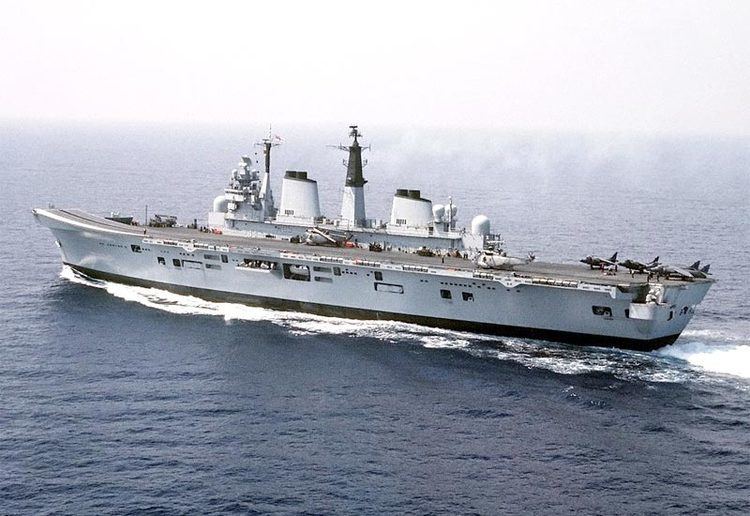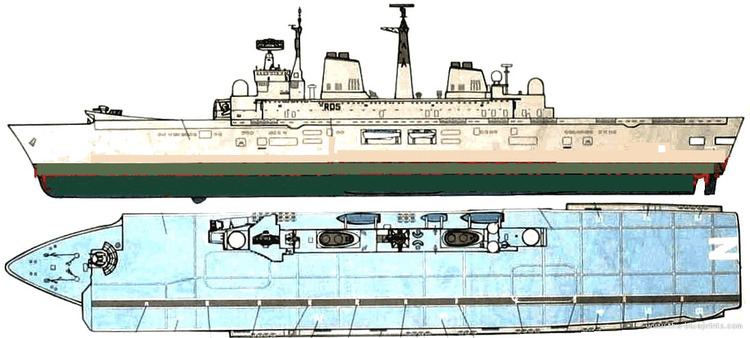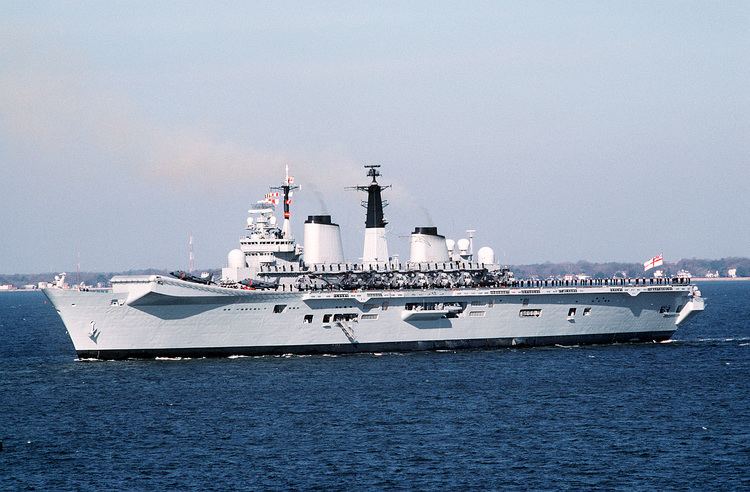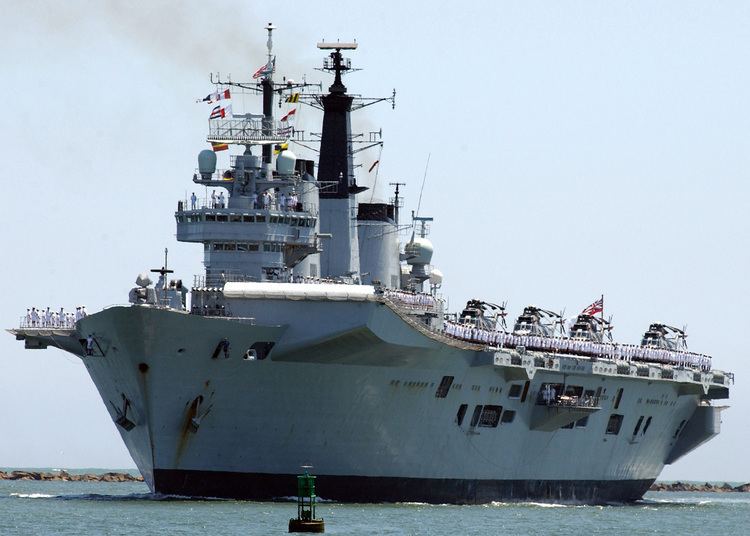Ordered 17 April 1973 Decommissioned 3 August 2005 Construction started July 1973 Length 210 m Tonnage 16 million kg | Laid down July 1973 Commissioned 11 July 1980 Launched 3 May 1977 Draft 8.81 m Beam 36 m | |
 | ||
Builder Vickers Shipbuilding and Engineering | ||
Hms invincible r05
HMS Invincible was the Royal Navy's lead ship of the three light aircraft carriers in her class. She was launched on 3 May 1977 as the seventh ship to carry the name. She saw action in the Falklands War when she was deployed with HMS Hermes and took over as flagship of the British fleet when Hermes was sold to India. Invincible was also deployed in the Yugoslav Wars and the Second Gulf War (Iraq War). In 2005, she was decommissioned and eventually sold for scrap to the Turkish company Leyal Ship Recycling in February 2011.
Contents
- Hms invincible r05
- History
- Proposed sale and Falklands War
- 19832005
- 20052011
- Weapons and aircraft
- Commanding Officers
- References

History

Invincible was built at Barrow-in-Furness by Vickers Shipbuilding and Engineering. She was laid down in 1973, launched on 3 May 1977 and commissioned on 11 July 1980, whereafter she joined the fleet's other carriers Hermes and Bulwark in service.
Proposed sale and Falklands War

On 25 February 1982, after several months of negotiations, the Australian government announced that it had agreed to buy Invincible for £175 million as a replacement, under the name HMAS Australia, for the Royal Australian Navy's HMAS Melbourne. The sale was confirmed by the Ministry of Defence.

On 2 April 1982, however, Argentina invaded the Falkland Islands. Three days later, a naval task force headed by Invincible and Hermes left HMNB Portsmouth bound for the South Atlantic and, on 20 April, the British war cabinet ordered the repossession of the Islands. Along with eight Sea Harriers, the Invincible's airgroup included twelve Sea King helicopters that were slightly larger than the ship had originally been designed to accommodate. Small machine guns were added around the flight deck and island for close-in defence.

On 23 April, while en route from Ascension Island to the Falklands, Invincible mistakenly locked her Sea Dart missile system on a VARIG Brazilian Airlines DC-10 rather than on the Argentine Air Force Boeing 707 that had been monitoring the fleet's movements. The previous day, Task Group Commander Rear Admiral "Sandy" Woodward had sought permission from Commander-in-Chief Admiral Sir John Fieldhouse to shoot down the 707 as he believed its activity indicated a raid would be launched from the Argentine aircraft carrier ARA Veinticinco de Mayo. As the 707 would be no direct threat to the fleet, Woodward ordered Weapons Tight and the continued tracking of the aircraft's course while a Sea Harrier was dispatched to investigate. The Harrier pilot reported that "it was a Brazilian airliner, with all the normal navigation and running lights on." Details of the Harrier interception appeared in the Brazilian press along with the claim that the DC-10's passengers were "alleged to have been frightened" and Woodward's comment that "[i]nconvenience to passengers' underwear regretted unless any of them were Argentinian".

On 1 June, Australian Prime Minister Malcolm Fraser advised the British government that the sale of Invincible to Australia could be cancelled if desired. In July 1983, a year after the end of the Falklands conflict, the Ministry of Defence announced that it had withdrawn its offer to sell Invincible so it could maintain a three-carrier force.
Although Argentina claimed to have damaged the ship during the conflict, this was officially denied by the British government and no evidence of any such damage has been produced or uncovered.
1983–2005
In December 1983, Invincible was refused the use of dry dock facilities in Sydney when the Royal Navy declined to divulge to the Australian authorities whether or not the ship was carrying nuclear weapons.
Between 1993 and 1995, Invincible was deployed in the Adriatic for Operation "Deny Flight" and then Operation "Deliberate Force" during the Yugoslav Wars. In 1997, flying the flag of Rear-Admiral Alan West, Commander UK Task Group, Invincible led a deployment that included 3 Commando Brigade Royal Marines. During the following two years, Invincible contributed to Operation "Bolton" (part of Operation "Southern Watch") in southern Iraq before she was redeployed to the Balkans to support the NATO action against Yugoslavia over Kosovo. There, while her helicopters aided refugees, her Harriers were involved in military strikes.
2005–2011
On 6 June 2005, the Ministry of Defence announced that Invincible would be inactive until 2010 but available for reactivation at eighteen months' notice. She was decommissioned on 3 August 2005, twenty months after an extensive refit that had been intended to give her ten more years of service. Illustrious succeeded her as the service's flagship. The Royal Navy maintained that Invincible could have been deployed had the need arisen and that Navy policy assumed she was still an active aircraft carrier. According to Jane's, however, Invincible had been stripped of some parts for her sister ships, so operational readiness would require not only eighteen months but also the replacement or removal of systems from those other ships.
In March 2010, Invincible was tied up and minimally maintained with other decommissioned ships up-river of HMNB Portsmouth. On 10 September 2010, she was struck off the Naval Reserve List and, in December, offered for sale by the Disposal Services Authority (DSA) with tenders due by 5 January 2011. The DSA tender documents confirmed that the ship's engines had been removed and that its generators and pumps were "generally unserviceable or not working". On 8 January 2011, the British press relayed an earlier report in the South China Morning Post that a £5-million bid had been made for the ship by the UK-based Chinese businessman Lam Kin-bong with plans to moor her at Zhuhai or Liverpool as a floating international school. In light, however, of China's re-arming of the Varyag – bought under a similar pretext – and the EU arms embargo on China, doubts were raised as to whether such a sale would go ahead.
A month later, in February 2011, BBC News reported that the Ministry of Defence had announced the sale of Invincible to Leyal Ship Recycling in Turkey. She was towed out of Portsmouth on Thursday 24 March and arrived at Leyal's Aliağa yard on 12 April 2011 for scrapping. By June 2011, work was underway to break up the ship.
Weapons and aircraft
Invincible initially lacked any close-in weapon systems. As one of the lessons from the Falklands War Invincible had two 20 mm Raytheon Phalanx close-in weapon systems fitted but these were later upgraded to three Thales 30 mm Goalkeeper CIWS; there are also two Oerlikon 20 mm cannons. Countermeasures were provided by a Thales jamming system and ECM system, Seagnat launchers provide for chaff or flare decoys. Initially the carriers were armed with a Sea Dart SAM missile system, but this was removed to enlarge the flight deck and to allow magazine storage and deck space for Royal Air Force Harrier GR7s.
After the various refits, the carrier's air group grew from the original planned 5 Sea Harriers and 9 Sea Kings to nine Sea Harrier or Harrier GR7/9s and twelve helicopters (usually all Sea Kings, either anti-submarine warfare (ASW) or Airborne Early Warning (AEW) variants). Alternative airgroups were occasionally tested with 16 Harriers and 3 helicopters being embarked. The carrier was equipped with flagship facilities and could provide an operational headquarters for Royal Navy task forces. The runway was 170 metres (560 ft) long and included the ship's characteristic ski jump (initially at an angle of 7°, but later increased to 12°).
